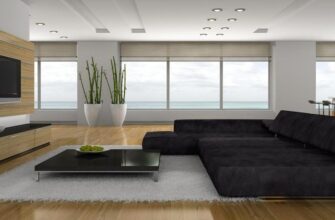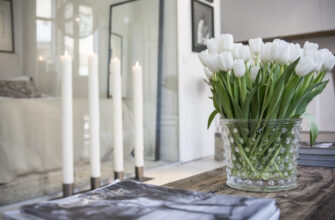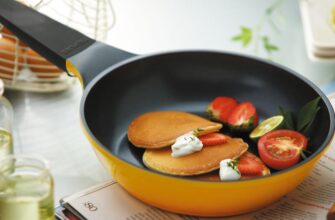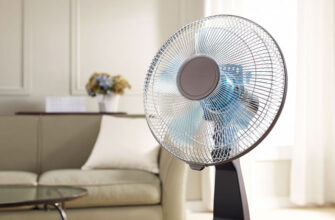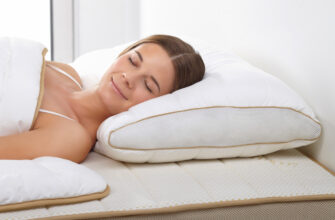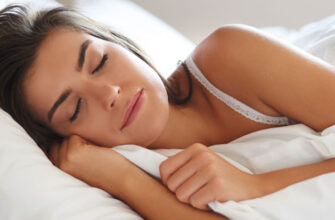Curtains allow you to create a cozy atmosphere in the house, expand or narrow the room and decorate the most ordinary interior. Today we will tell you how to choose the right curtains for each room and what parameters you should pay attention to when buying.
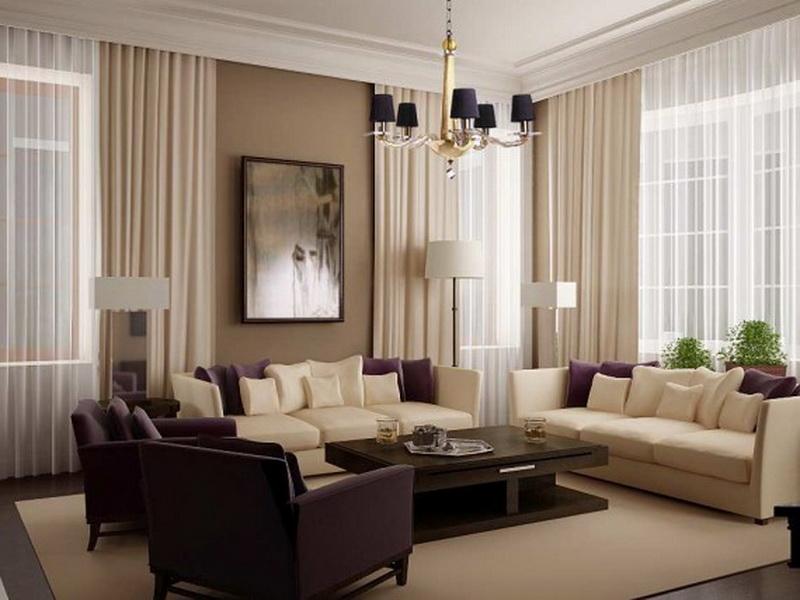
- The best curtain manufacturers
- The most popular types of curtains
- Classic curtains
- disadvantages
- Roller blinds
- disadvantages
- Roman curtains
- disadvantages
- Japanese curtains
- disadvantages
- French curtains
- disadvantages
- Austrian curtains
- disadvantages
- Italian curtains
- disadvantages
- What other types of curtains are
- Curtain selection options
- Types of fasteners for classic curtains
- Eyelets
- Hinges
- Ties-ribbons
- Drawstring mount
- Curtain tape
- Choosing the color of the curtains
- Choosing a fabric for curtains
- Curtain length
- What curtains to choose – practical advice
- How much do the curtains cost
The best curtain manufacturers
It's hard to say which of the manufacturing companies is the leader in the creation of curtains for windows. There are a huge number of companies sewing these products, and most of them produce high quality products. But we can name those manufacturers whose products are most popular among residents of the Russian Federation and the CIS countries:
-
Haft;
-
Wisan;
-
Primavera;
-
Amore mio;
-
Garden;
-
RTKS;
-
Zlata korunka;
-
Realtex.
No less often, people order sewing of curtains in an atelier, and the appearance, design and service life of these textiles depend on the choice of material. Therefore, it is so important to buy curtain fabric from a good manufacturer. The most famous companies in the world producing luxury, high quality and expensive materials are:
-
Rubelli;
-
Etro home collection;
-
Ralph lauren;
-
Missoni;
-
Nina Campbell;
-
Antico setificio fiorentino;
-
Jim thompson;
-
De le cuona;
-
Lee jofa;
-
Marvic textiles.
The most popular types of curtains
Classic curtains
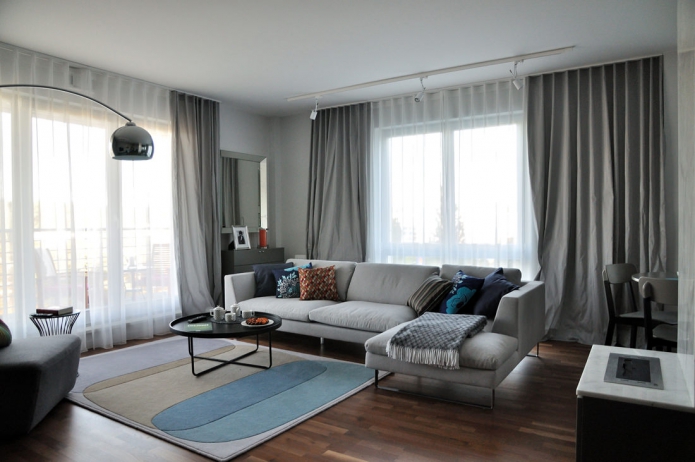
Traditional curtains are straight sliding curtains made of thick fabric, which are often combined with tulle curtains. They are made from materials with a wide variety of textures and patterns. Often, such products are decorated with lambrequins – a fabric drapery located over the curtains along the entire width of the cornice. Lambrequins hide the cornice and allow you to visually reduce or increase the size of the window.
Advantages
-
Suitable for almost all premises: nursery, living room, bedroom, office.
-
Easy maintenance – most curtains can be machine washed;
-
Classic models can be produced for all window sizes.
-
A wide variety of models – curtains can be selected for almost any style of interior, be it modern, classic, country, etc.
disadvantages
-
Dense curtains (especially models with complex drapery) with stubborn stains should be dry-cleaned.
-
Fade over time and absorb odors.
-
Classic curtains tend to accumulate dust.
Roller blinds
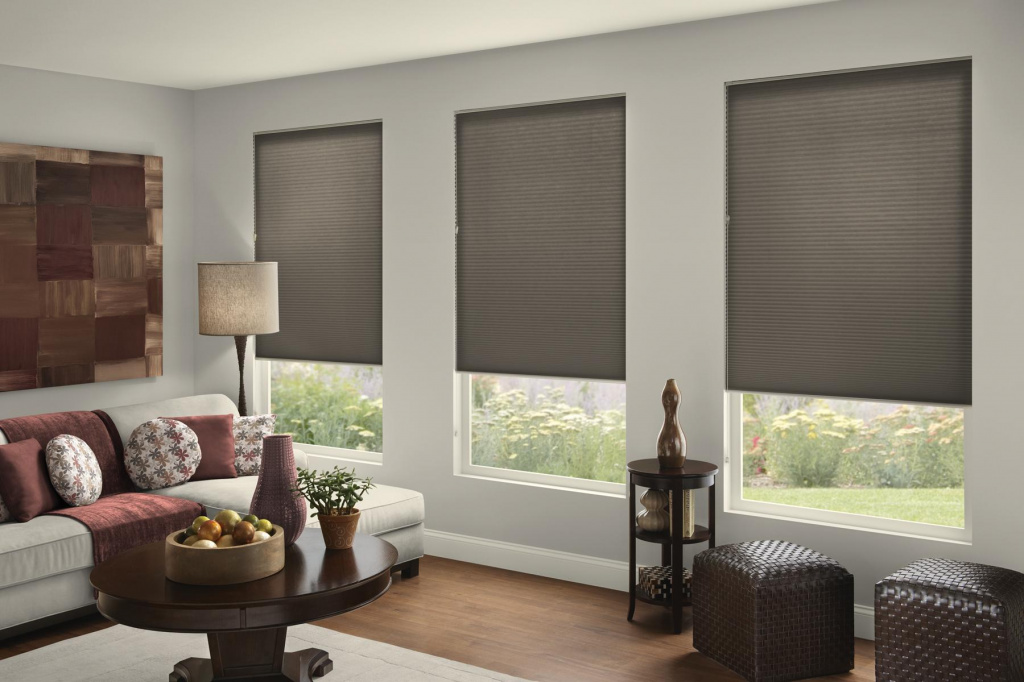
These products are fabrics made of rigid fabric, which are wound on a shaft using manual or automatic control. They are translucent and transparent, and some of them are capable of completely blocking sunlight.
Such models can be used in any room and combined with other types of curtains, for example, classic ones. They can be installed on a wall, window frame or in an opening and used for large windows, skylights and display cases.
Advantages
-
Roller blinds are protected from dust, moisture, dirt and burnout. treated with a special solution.
-
Some models can protect from 100% of the sun's rays – this is important for rooms with a sunny side.
-
They are easy to care for – just clean with a damp cloth or treat with detergents.
disadvantages
-
The fragility of the mechanism – they can break with frequent and prolonged use.
-
Products installed in the opening make it difficult to open a window or window.
Roman curtains

These models are similar to roll-to-roll, but they are not wound on the shaft, but tucked in with a cord. When lifting, wide folds are formed. A wide variety of materials can be used in their production, including blackout fabric, which completely protects from the sun's rays.
Advantages
-
Perfectly protect the room from the sun and prying eyes.
-
A wide range of fasteners – they can be installed on the wall above the window opening, attached to the ceiling or to the window profile.
-
These products can be combined with sliding curtains.
-
Ease of use – pull the chain or press a button on the remote control to open the shade.
disadvantages
-
The curtain adjustment mechanism may break.
-
It is inconvenient to wash. To do this, carefully remove and disconnect the product from the lifting mechanism, remove the lamellas (hard twigs, due to which folds are formed), wash and repeat the process in reverse
Japanese curtains
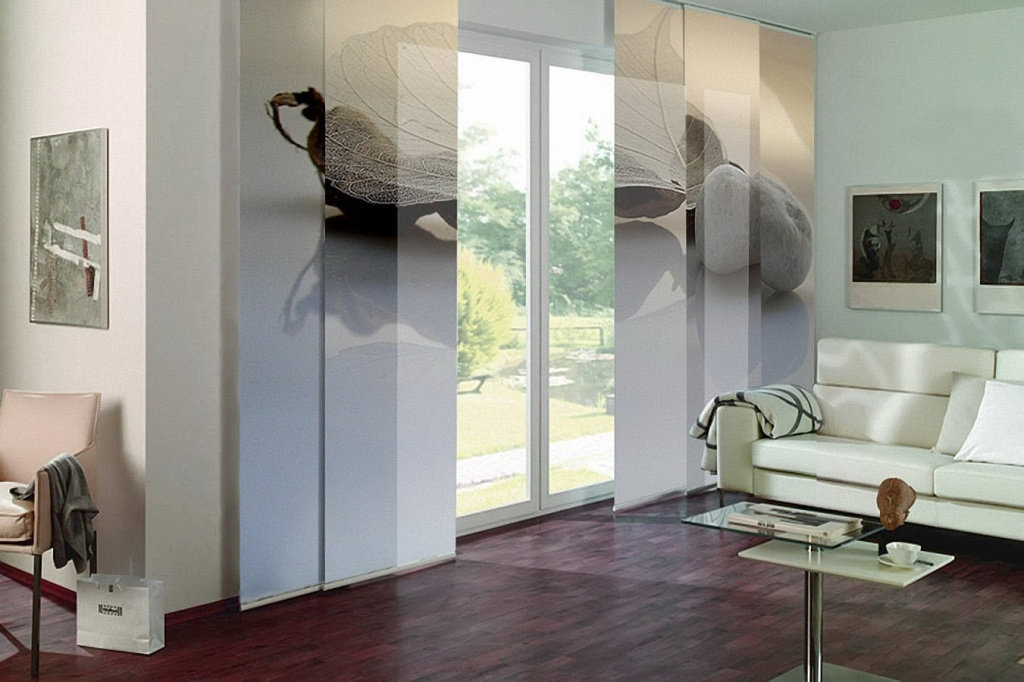
Japanese curtains or curtains-panels are flat fabrics made of fabric material, the movement of which along the cornice is regulated by a cord or an electric drive. The lower part of the curtains is weighted so that no folds form on them. They have a laconic, austere look, are often used to create a style of minimalism, avant-garde, and, of course, oriental style in the interior.
Advantages
-
Do not accumulate dust.
-
They can be used to divide one room into several zones.
-
They take up little space in the room.
-
Good protection from sunlight.
-
Suitable for large windows and large rooms – usually four or more canvases are used.
disadvantages
- Not suitable for small windows and small apartments.
French curtains
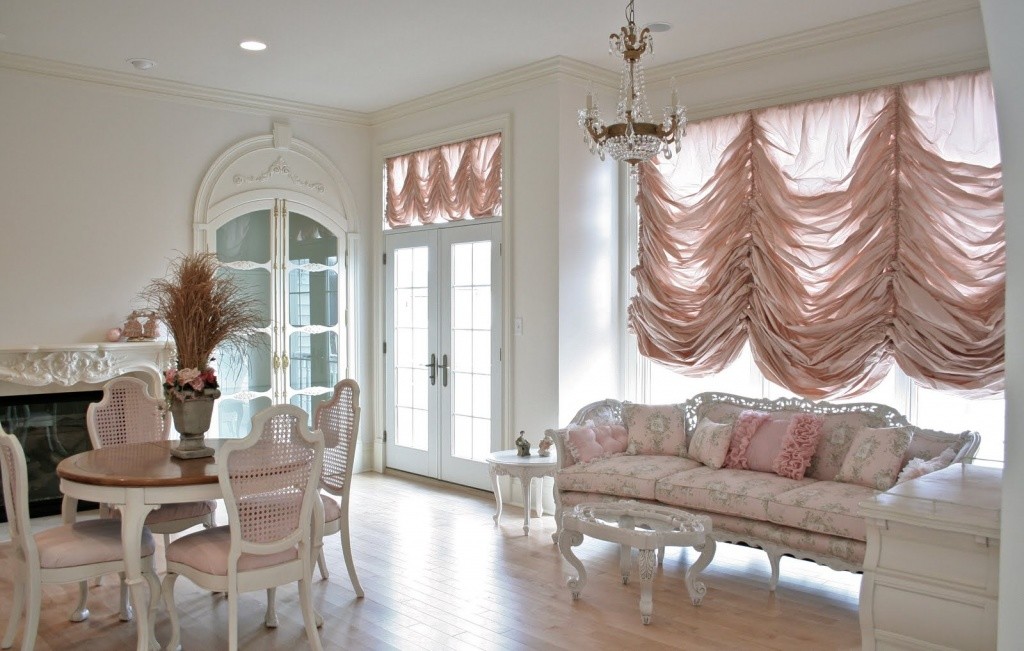
They are fabrics (linen, silk, polyester, organza, cotton and tulle), the length of which is adjusted using a rotary chain mechanism. The person pulls on the chain, the chain activates the block, which in turn pulls the ribbons attached to the product, lifting it.
French curtains have a beautiful and solemn look thanks to the flowing draperies. They are ideal for classic, empire and baroque interiors.
Advantages
-
Suitable for rooms with high ceilings and large windows.
-
Go well with curtains and lambrequins.
-
They create an exquisitely luxurious look of the room.
disadvantages
-
Poorly retard the sun's rays, because sewn from lightweight fabrics.
-
Due to the large number of folds, dust accumulates.
-
Poorly suited for small apartments.
Austrian curtains
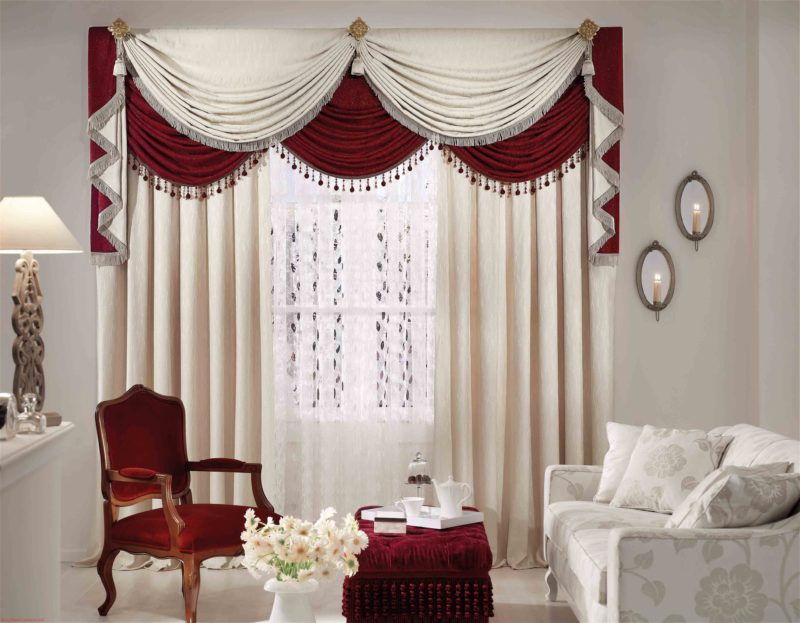
Austrian curtains are fabrics of silk, voile, polyester, organza or cambric, the lower part of which is gathered in horizontal folds, also known as puffs. They are regulated, like French curtains, using a rotary chain mechanism. When the curtains are raised, more lush folds are formed.
These models are most often sewn from light and translucent models, which gives a special 'airiness' to the interior, but they can also be sewn from dense materials.
Advantages
-
Suitable for large windows and rooms with high walls.
-
They take up little space.
-
Suitable for almost any room.
disadvantages
-
Are expensive.
-
Collect dust.
Italian curtains
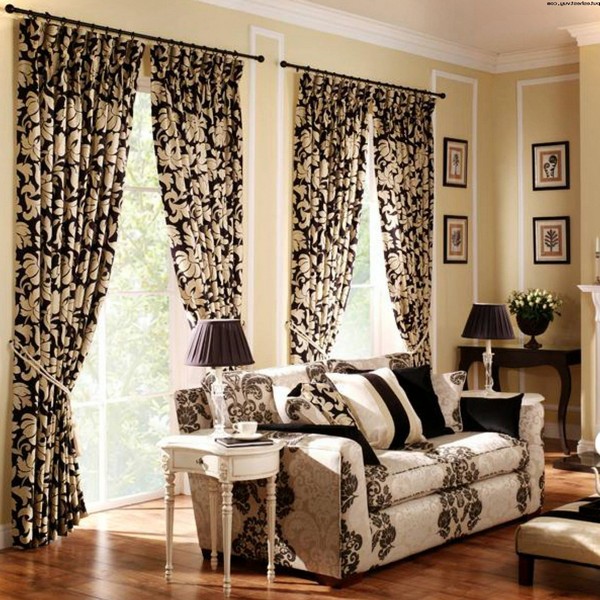
These products do not slide apart completely, but are assembled with special laces, ribbons, buttons, bows and other decorative elements. They are often used in restaurants, theaters and museums.
Advantages
-
Great for large windows and large apartments.
-
Suitable for non-standard window openings.
-
Can be matched to almost any interior.
disadvantages
-
Italian curtains are not appropriate for kitchens and tiny rooms.
-
Burn out when exposed to sunlight and collect dust.
What other types of curtains are
In addition to the above types of curtains, one can distinguish:
-
Photo curtains can have a variety of prints. Models with cartoon characters are perfect for children's rooms, landscapes and other types of nature for a bedroom or living room, and floral motifs or 'delicious' prints for the kitchen.
-
Balcony curtains are designed specifically for balcony blocks: windows and doors located next to each other. As a rule, they consist of two curtains – short for the window and long for the door. Most often they are made of light, light-transmitting fabrics, mainly polyester.
-
Rope (thread) products are usually made of polyester. They are used not only for windows, but also as a partition between rooms.
Curtain selection options

Types of fasteners for classic curtains
Eyelets
Eyelets are rings of plastic or metal attached to the slotted holes at the top of the curtain. They are put on the cornice tube, due to which even horizontal folds are formed along the entire canvas.
Curtains with eyelets are easy to slide open and close, remove before washing and hang. Thanks to the rings, they wear out slowly and, unlike curtains with hooks, which can easily slip off, they attach securely to the eaves. Such curtains move with sound.
Eyelets can have different colors and even shapes: in the form of a steering wheel, square, flower, animal, etc.
Hinges
The hinged curtains are attached to the cornice with loops sewn to the top of the canvas. They are made from the same material as the main product, and can be solid (stitched to the canvas on both sides) and unfastened (with Velcro, buttons or buttons). The number of loops depends on the size and weight of the curtain – the heavier the product, the more loops you need.
These curtains are suitable for almost all types of curtain rods. The movement of the canvas is silent, which is a plus if a small child is sleeping in the room. But over time, the hinges wear out and need to be replaced.
Ties-ribbons
Curtains with ties resemble curtains with loops, but in this case, the canvas must be tied to the cornice. It looks beautiful and gentle, therefore it is often used to create a romantic setting. But it takes time to hang such a product. It is also important to tie all ribbons the same way, otherwise the curtain will be 'crooked'.
Drawstring mount
Drawstring curtains have a special 'pocket' at the top that fits over the curtain rod. Due to this, the movement of the tissue occurs silently.
Such models are great for decorating kitchen windows, arched windows, rustic rooms.
Curtain tape
A ribbon is sewn to the top of such models, which is put on the hooks of the cornice. With its help, you can tighten the canvas to form vertical folds.
Choosing the color of the curtains
-
Remember that dark products visually reduce the room, while light shades increase it.
-
Curtains made in bright flashy colors cannot be combined with equally bright dominant objects in the room. If the interior of the room already has a rich color scheme, it is better to dwell on plain, neutral curtains.
-
To make the room wider, use two-tone canvases with wide horizontal stripes, to make them narrower with vertical ones.
-
The curtains should not completely match the color of the walls. They should be either darker or lighter.
-
For the bedroom, it is best to choose calm and soothing colors (green, cream, apricot, blue or sand).
-
In the living room, you can choose completely different shades of curtains, the main thing is that they are combined with the design of the room.
-
Canvases of light colors are often chosen in the kitchen, which let the sun's rays through well.
-
When buying curtains for a nursery, remember that little kids love fun, bright colors and large prints, while teenagers prefer darker colors.
Choosing a fabric for curtains
Silk, cotton, tulle, brocade, velor and velvet, organza, as well as polyester, viscose and acrylic are often used in the production of curtains. Curtains made of synthetic materials are unpretentious in maintenance, they retain their color for a long time. Products made from natural fabrics are of better quality, they do not accumulate static electricity, they collect less dust and look richer.
Curtain length
Curtains can be short, floor-length, long and standard:
-
Short curtains are usually used for decorating bathrooms and kitchens, but they also look good in bedrooms and small living rooms. Such models are suitable for small apartments, allowing you to put furniture near the window and thus expand the room. They go well with lambrequins, draperies and other decorative elements. In addition, the curtains to the windowsill collect less dust, which usually accumulates near the baseboards, and it is easier to care for them. But they don't look good in rooms with low ceilings. visually make the height even smaller.
-
Standard models are suitable for any room, be it a bedroom, a nursery or a hall. They do not interfere during cleaning, since the distance between the lower edge of the canvas and the floor is 5–6 cm. But it is not recommended to buy them for apartments whose walls are less than 2.5 m high.
-
Floor-length curtains do not touch the floor – about 1-1.5 cm remains between the bottom edge of the product and the floor. Such models look very beautiful in living rooms, bedrooms and halls. They visually increase the height of the ceiling and cover ugly baseboards and old radiators.
-
Curtains lying on the floor look graceful and elegant. They are often used to decorate window openings in bedrooms and living rooms. But overly long canvases collect dust and dirt and make cleaning difficult. In addition, it is undesirable to use them in rooms with animals.
What curtains to choose – practical advice

-
The kitchen in most apartments is small in size, so it is better to use short curtains for it that transmit light well. Roll products will also be an excellent option – grease and dirt do not stick to them, and they look very stylish.
-
To decorate windows in the bedroom, floor-length curtains and curtains lying on the floor, made of thick fabric, are often used, which protect well from the sun's rays. They can be combined with models made of translucent material.
-
If the bedroom or nursery is small, use roman or roller blinds. So you save space and protect your baby from the sun.
-
You should not buy curtains lying on the floor for the nursery, otherwise the child may stumble over the ends of the curtains, and the canvases themselves quickly get dirty.
-
Drapery curtains look good in any room. With their help, you can visually change the size of the room and the shape of the window, hide flaws and 'increase' the height of the ceiling.
-
For small windows, it is recommended to choose Roman, Austrian and roller blinds.
-
In the living room, products from dense expensive fabric with lush folds look good.
-
For the bay window in the living room, you should choose Roman, French and Austrian curtains, thanks to which the room will look luxurious. If the bay window is in the kitchen, it is better to use roller blinds to decorate it. Curtains with lambrequins and classic curtains look great on the bay window.
How much do the curtains cost
-
Curtain prices can vary from 300 rubles. (for short polyester curtains) up to 65,000 rubles. for the luxurious classic jacquard curtains.
-
The average budgetary cost of classic curtains is 2,000-5,000 rubles, but luxury models are much more expensive – 30,000-50,000 rubles.
-
Roller blinds can be bought for 1,000–5,000 rubles, and models with an electric drive will cost you 15,000–20,000 rubles.
-
The average price for Japanese curtains is 1,000–3,000 rubles.
-
The more fabric was used for the curtain, the more expensive it will be. Therefore, the cost of products lying on the floor, models on a curtain tape, Austrian and French curtains will be higher than prices for conventional straight canvases.
In the following articles, our experts tell you how to choose a stylish sofa, the secrets of choosing a chandelier for an apartment and the features of choosing a beautiful vase for a bedroom, living room, kitchen.
Attention! This material is the subjective opinion of the authors of the project and is not a purchase guide.


